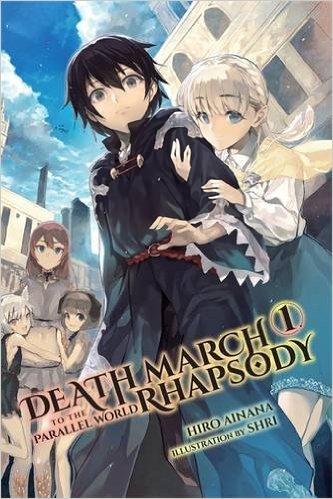By Hiro Ainana and shri. Released in Japan by Fujimi Shobo. Released in North America by Yen On. Translated by Jenny McKeon.
For all that we talk about the cliche of the “transported to another world” genre (‘isekai’ in Japan), we haven’t actually seen too many pure examples of the genre itself in the light novels we’ve had translated. There have been slight variations – DanMachi essentially works on the same principles, only Bell is not from another world. SAO and Log Horizon have people trapped in literal game worlds. We’ve seen deconstructions, like Re: Zero and Grimgar of Fantasy and Ash. And next month we’ll see an outright parody with KonoSuba. Even this series I’m reviewing today, which comes closest to the original form, has a variation in that the hero is a late-20s salaryman in his old teenage body, and thus his thoughts are more of an adult’s. And honestly, there’s a reason we haven’t seen too many of the ‘standard’ types of isekai novels: they’re standard male wish-fulfillment.
Our hero is Satou, a game designer who falls asleep after a rough coding session and wakes up in a desert-like area where he’s about to be killed by lizard people. He thinks he’s dreaming and imagining he’s in a game, mostly as he can see his stats on a screen in front of him. So he tries the stupidly overpowered move that he and his boss were discussing earlier, which causes a giant meteor shower to take out the enemy. And then a bigger one to take out a dragon god. Doing this levels Satou up to absolutely ridiculous levels, and since he also has a Bag of Infinite Holding and a giant pile of money… even most self-insert fanfics don’t go this far. He goes to the nearest city, which is battling wyverns and demons and such, and slowly learns about the world he’s now in. Very, very slowly.
The difficulty with these male power fantasy books is that the hero is meant to be one that the reader can just swap out and substitute with themselves, and as a result can’t have too many signifying traits that might differ from said reader. This means that the novel’s big weakness is Satou, who is a giant yawning void where a protagonist should be. Since he’s got a teenage body but his mind is that of his old 29-year-old game developer self, he’s rather calm and stoic about things like love. And since he WAS a game designer, he can handle most of the cliches that come his way to try to kill him, especially as he’s got his God Stats, his Unlimited Items, and his Unlimited Money. Stoic emotionless heroes can work in the right context – Overlord and The Irregular at Magic High School have similar types. But there needs to be something behind them, something other than “well, here’s a monster, splat, OK, next?”. Also, he needs to stop telling everyone he’s not a lolicon every other line, or folks are going to get suspicious.
As for the rest of the book, well, it was all right. I never thought I’d say this about any work ever, but: this book is crying out for a tsundere to get angry with the hero. The female knight Satou saves falls for him immediately, and the three slaves he takes on (Satou is against slavery, but circumstances are such that he can’t do much about it) are all fairly meek and willing to do anything he says. If there is one bright light in this book, it is the stat updates that accompany Satou whenever he does anything, which range from the practical to the hilarious, and are easily the best part of the book. If you want to see what a garden variety isekai work is, you may want to give Death March a try. Everyone else is better off sticking with the subversions, deconstructions and parodies, though.

